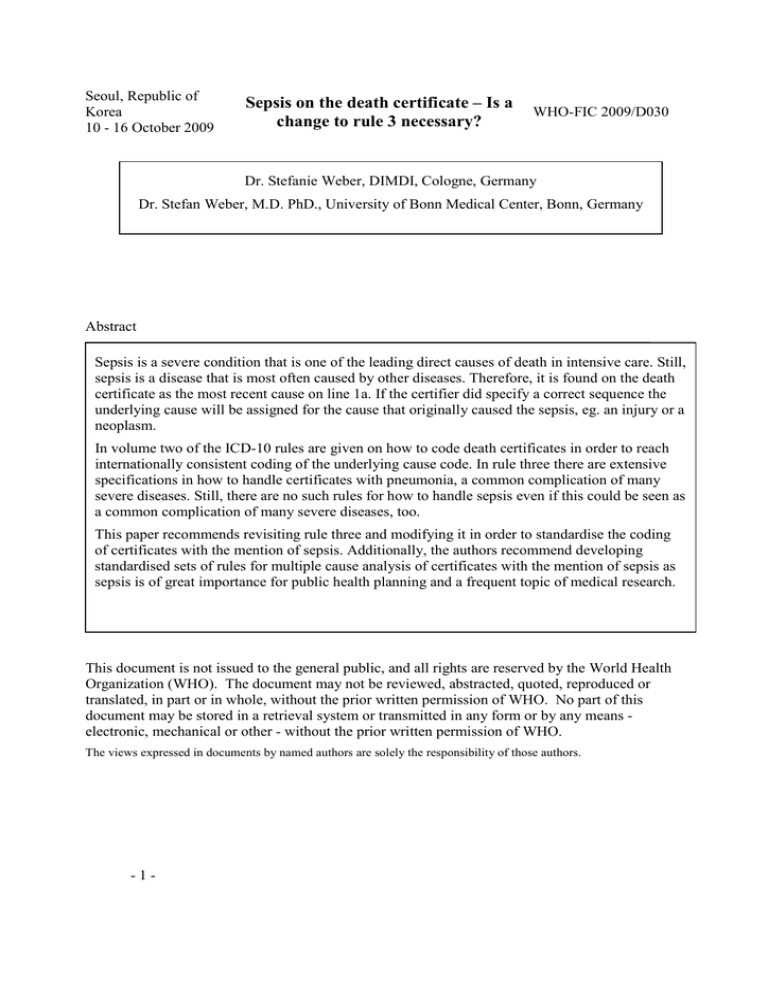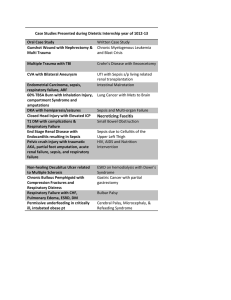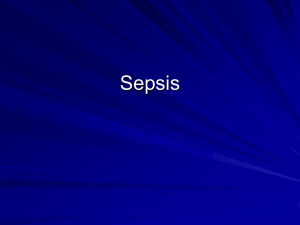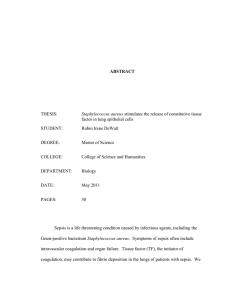
Seoul, Republic of
Korea
10 - 16 October 2009
Sepsis on the death certificate – Is a
change to rule 3 necessary?
WHO-FIC 2009/D030
Dr. Stefanie Weber, DIMDI, Cologne, Germany
Dr. Stefan Weber, M.D. PhD., University of Bonn Medical Center, Bonn, Germany
Abstract
Enter Abstract here
Sepsis is a severe condition that is one of the leading direct causes of death in intensive care. Still,
sepsis is a disease that is most often caused by other diseases. Therefore, it is found on the death
certificate as the most recent cause on line 1a. If the certifier did specify a correct sequence the
underlying cause will be assigned for the cause that originally caused the sepsis, eg. an injury or a
neoplasm.
In volume two of the ICD-10 rules are given on how to code death certificates in order to reach
internationally consistent coding of the underlying cause code. In rule three there are extensive
specifications in how to handle certificates with pneumonia, a common complication of many
severe diseases. Still, there are no such rules for how to handle sepsis even if this could be seen as
a common complication of many severe diseases, too.
This paper recommends revisiting rule three and modifying it in order to standardise the coding
of certificates with the mention of sepsis. Additionally, the authors recommend developing
standardised sets of rules for multiple cause analysis of certificates with the mention of sepsis as
sepsis is of great importance for public health planning and a frequent topic of medical research.
This document is not issued to the general public, and all rights are reserved by the World Health
Organization (WHO). The document may not be reviewed, abstracted, quoted, reproduced or
translated, in part or in whole, without the prior written permission of WHO. No part of this
document may be stored in a retrieval system or transmitted in any form or by any means electronic, mechanical or other - without the prior written permission of WHO.
The views expressed in documents by named authors are solely the responsibility of those authors.
-1-
WHO-FIC 2009/D030
Sepsis - a severe disease with a high mortality ratio
Despite recent advances in medicine sepsis remains one of the leading immediate causes of death
in critically ill patients. Sepsis is defined as Systemic Inflammatory Response Syndrome (SIRS)
caused by an infective organism, may it be bacterial, viral or fungal. Depending on severity of the
disease, severe sepsis is defined as sepsis with organ failure, while multiple organ dysfunction
syndrome (MODS) indicates malfunction of more than one organ. Infection related organ
dysfunction in this context of severe sepsis relates to acute encephalopathy, thrombocytopenia and
arterial hypoxemia as a sign of pulmonary dysfunction, arterial hypotension, renal failure and
metabolic acidosis. Finally, septic shock is defined as sepsis with hypotension in spite of adequate
volume resuscitation. The pathophysiology of sepsis is determined by a dysregulated immune
system with hyper- and hypo-inflammatory aspects causing impairment on multiple levels.
SIRS occurs in up to 80% of critically ill patients and up to 30% will progress to sepsis. A further
10-15% will develop severe sepsis and multiple organ failure [1]. According to Brun-Buisson the
overall mortality for sepsis ranges around 20 % and up to 40-60% for patients with septic shock
[1]. According to estimates within the United States there is a prevalence of 3 cases per 1000
citizens acquiring sepsis. In the United States, the average morbidity is 28,6% and increases up to
38.5% for patients above 85 years of age. The overall costs for treating sepsis run at 16.7 million
dollars US per annum , 22.000 $ per case. Since 1995 the incidence has been steadily increasing
by 1.5 % per year [2;3]. In Germany, a recent survey of the SepNet study group reported a 54%
mortality in severe sepsis [4;5]. A French multicentred study revealed that most cases of sepsis are
nosocomial, up to 25% are acquired within the critical care setting.
Sepsis coding – not clearly regulated
The coding of septicaemia is inconsistent and not explicitly regulated in Volume 2. As sepsis is a
disease that rarely is found as a single diagnosis but rather develops as a consequence of another
severe disease. In cases where all diagnoses are entered in part one of the death certificate it is
easy to establish the correct causual relationships and to reach the correct underlying cause. But
what about cases where only sepsis is entered in part one and other severe diseases in part 2 of the
certificate?
For pneumonia elaborate regulations are formulated for such certificates in Rule 3. Some of these
might as well apply for sepsis.
In the following Table a list of conditions is given that are mentioned in rule 3 for combination
with pneumonia. From a medical point of view it does not make sense to treat sepsis differently for
some of the diagnosis.
Pneumonia
According to Rule 3 combined with
J18.1 (Lobar pneumonia, unspecified)
F10.2 (Mental and behavioural disorders due to use of
alcohol - Dependence syndrome)
J12-J18
Conditions that impair the immune system
J15.0-J15.6, J15.8-J15.9, J16.8, J18.0 and
Wasting diseases (such as malignant neoplasm and
-2-
J18.2-J18.9
malnutrition)
J15.0-J15.6, J15.8-J15.9, J16.8, J18.0 and
J18.2-J18.9
Diseases causing paralysis (such as cerebral
haemorrhage or thrombosis)
J15.0-J15.6, J15.8-J15.9, J16.8, J18.0 and
J18.2-J18.9
Serious respiratory conditions
J15.0-J15.6, J15.8-J15.9, J16.8, J18.0 and
J18.2-J18.9
Communicable diseases
J15.0-J15.6, J15.8-J15.9, J16.8, J18.0 and
J18.2-J18.9
Serious injuries.
J15.0-J15.6, J15.8-J15.9, J16.8, J18.0 and
J18.2-J18.9, J69.0, and J69.8
Conditions that affect the process of swallowing
The following list of codes shows the sepsis codes in Volume 1 which might be applicable for
such a combination via Rule 3:
A02.1 Salmonella septicaemia
A22.7 Anthrax septicaemia
A24.1 Acute and fulminating melioidosis
A26.7 Erysipelothrix septicaemia
A32.7 Listerial septicaemia
A40.0 Septicaemia due to streptococcus, group A
A40.1 Septicaemia due to streptococcus, group B
A40.2 Septicaemia due to streptococcus, group D
A40.3 Septicaemia due to Streptococcus pneumoniae
A40.8 Other streptococcal septicaemia
A40.9 Streptococcal septicaemia, unspecified
A41.0 Septicaemia due to Staphylococcus aureus
A41.1 Septicaemia due to other specified staphylococcus
A41.2 Septicaemia due to unspecified staphylococcus
A41.3 Septicaemia due to Haemophilus influenzae
A41.4 Septicaemia due to anaerobes
A41.5 Septicaemia due to other Gram-negative organisms
A41.8 Other specified septicaemia
A41.9 Septicaemia, unspecified
A42.7 Actinomycotic septicaemia
B00.7 Disseminated herpesviral disease
B37.7 Candidal septicaemia
WHO-FIC 2009/D030
Sepsis coding – a step forward?
The authors propose a two step approach to this problem:
1. For a near future change to Volume 2 obvious reasons for sepsis should be mentioned in
Rule 3 for combination, like multiple injuries, major surgery or diseases involving long
term Intensive care treatment.
2. A more detailed investigation should be performed on multiple cause data and then be
analysed thoroughly from a medical and scientific view to develop:
a. Specific rules for Volume two on which causes should be combined with Sepsis
b. Develop multiple cause analysis templates for sepsis in order to further investigate
this diagnosis of great medical, financial and public health impact.
References
[1] Brun-Buisson C. The epidemiology of the systemic inflammatory response. Intensive Care
Med .2000; 26 Suppl 1:S64-S74.
[2] Angus DC, Wax RS. Epidemiology of sepsis: an update. Crit. Care Med. 2001; 29(7
Suppl):S109-S116.
[3] Angus DC, Linde-Zwirble WT, Lidicker J, Clermont G, Carcillo J, Pinsky MR.
Epidemiology of severe sepsis in the United States: analysis of incidence, outcome, and
associated costs of care. Crit. Care Med. 2001; 29(7):1303-1310.
[4] Bauer M, Brunkhorst F, Welte T, Gerlach H, Reinhart K. [Sepsis : Update on
pathophysiology, diagnostics and therapy.] Sepsis: Aktuelle Aspekte zu Pathophysiologie,
Diagnostik und Therapie. Anaesthesist 2006 Jun 30 ; 2006; .
[5] Brunkhorst FM. [Epidemiology, economy and practice -- results of the German study on
prevalence by the competence network sepsis (SepNet)] Epidemiologie, Okonomie und
Praxis -- Ergebnisse der deutschen Pravalenzstudie des Kompetenznetzwerkes Sepsis
(SepNet). Anasthesiol Intensivmed Notfallmed Schmerzther 2006 Jan ;41 (1):43 -4 2006;
41:43-44.
-4-








